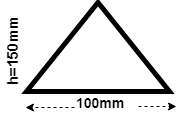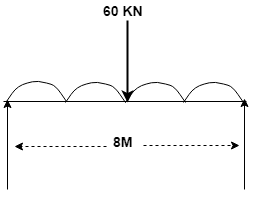This set of Strength of Materials Interview Questions and Answers for Experienced people focuses on “Maximum Shear Stress – 2”.
1. Calculate the maximum shear force for square beam of side is 320 mm. If the shear force is 94kN.
a) 1.37N/mm2
b) 2.36N/mm2
c) 5.21N/mm2
d) 4.32N/mm2
View Answer
Explanation: Maximum shear force is 3/2 × F/a×a ( a = side of square)
= 3/2 × 94×103/320×320
= 1.3769 N/mm2.
2. A simply supported beam of span 8 metres carries a udl of 16 kN/m at a point out of 60 kN acting at it’s centre. Calculate the maximum shear force.
a) 87kN
b) 45kN
c) 78kN
d) 94kN
View Answer
3. The ratio of creep strain to elastic strain is known as ___________
a) Creep factor
b) Creep postulate
c) Creep coefficient
d) Creep variable
View Answer
Explanation: Creep is defined as plastic deformation under a constant load or stress the creep Coefficient which is defined as the ratio of ultimate creep strain to the elastic strain at various ages of loadings.
4. Poisson’s ratio for high strength concrete is __________
a) 0.049
b) 0.095
c) 0.1
d) 0.1111
View Answer
Explanation: Poisons ratio varies between 0.1 for high strength concrete and 0.2 for weak concrete. Usually it is taken as 0.15 for strength design and 0.2 for serviceability conditions.
5. Partial safety factor for concrete is taken as ____________
a) 1.3
b) 1.2
c) 1.5
d) 1.6
View Answer
Explanation: A higher value of partial safety factor for concrete 1.5 has been adopted because there are greater chances of variation of the strength of concrete due to improper compaction, inadequate curing, improper batching and mixing.
6. The design compressive strength of concrete is ___________ times of characteristic compressive strength of concrete.
a) 0.313
b) 0.253
c) 0.466
d) 0.411
View Answer
Explanation: The compressive strength of concrete in the structure is assumed to be 0.67 times the characteristic strength of concrete. The partial safety factor equal to 1.5 is applied to the strength of concrete in addition to it therefore the design compressive strength of concrete is 0.67 fck / 1.5 equal to 0.446 fck. [fck = characteristic compressive strength].
7. In cantilever beams, the steel bars are placed at ___________
a) Bottom of the beam
b) Top of the Beam
c) Midspan of the Beam
d) Near supports
View Answer
Explanation: In cantilever beams, steel bars are placed near the top of the beam to resist the tensile stresses developed in top layers due to the negative bending moment that is hogging bending moment.
8. Calculate the level arm factor of a section of M20 grade and if Fe 415 Steel. [Take critical neutral axis factor as 0.289].
a) 0.78
b) 0.9
c) 0.58
d) 0.73
View Answer
Explanation: Lever arm factor (j) = 1-k/3
Where k= 0.289
j = 1-0.289/3
= 0.904~0.9.
9. Working stress method is based on elastic theory assumptions.
a) True
b) False
View Answer
Explanation: Working stress method is based on elastic theory assuming reinforced concrete as elastic material. The stress strain curve of concrete is assumed as linear from zero at the neutral axis to a maximum value at the extreme fibre. In the working stress method, members are designed for working loads such that the stresses developed are within the allowable stress.
10. Modular ratio method is also known as ______
a) Ultimate stress method
b) Limit state method
c) Working stress method
d) Stress and strain method
View Answer
Explanation: The stress in steel is linearly related to the stresses in adjoining concrete by constant factor called modular ratio (defined as the ratio of modulus of elasticity of steel to that of concrete) Working stress method is therefore also known as modular ratio method.
11. Find the moment of inertia about centroid axis of a triangular section are having base 100 mm and height 150 mm.

a) 9.21×106mm4
b) 9.45×106mm4
c) 9.37×106 mm4
d) 8.51×106 mm4
View Answer
Explanation: b = 100mm
h = 150 mm
Moment of inertia about centroid Axis = bh3 / 36.
= 100 ×1503/ 36
= 9.37×106mm4.
12. The stress corresponding to ______ of strain in the stress-strain curve of mild steel is known as proof stress.
a) 0.2%
b) 0.32%
c) 0.5%
d) 0.6%
View Answer
Explanation: The stress corresponding to 0.2% of strain in the stress-strain curve of mild steel is known as proof stress. This is also taken as yield stress. The maximum stress is generally taken as yield stress.
13. __________ is the device used for measuring normal stresses on the surface of a stressed object.
a) Nephelometer
b) Straining appurtenances
c) Resistance strain gauge
d) Volt-Hypsometer gauge
View Answer
Explanation: An electrical resistance strain gauge is a device for measuring normal strains on the surface of a stressed object. The gauges are small (less than half inch) made of wires that are bonded on surface of the object. We can use the transformation equations for plane strain to calculate the strains in various directions.
14. The compressive strength of brittle materials is ______ its tensile strength.
a) Less than
b) Greater than
c) Equal to
d) Depends on material
View Answer
Explanation: The compressive strength of brittle materials is always greater than its tensile strength. In the same way, the tensile strength of ductile materials is greater than its compressive strength.
15. The breaking stress is _______ the ultimate stress.
a) Less than
b) Greater than
c) Depends on time
d) Equal to
View Answer
Explanation: The stress corresponding to the ultimate load is known as ultimate stress and the stress corresponding to breaking point is known as breaking stress. In the stress strain curve, the ultimate stress is above the breaking stress. Hence the ultimate stress is greater than breaking stress.
Sanfoundry Global Education & Learning Series – Strength of Materials.
To practice all areas of Strength of Materials for Interviews, here is complete set of 1000+ Multiple Choice Questions and Answers.
If you find a mistake in question / option / answer, kindly take a screenshot and email to [email protected]
- Check Metallurgical Engineering Books
- Check Strength of Materials Books
- Practice Metallurgical Engineering MCQs
- Apply for Mechanical Engineering Internship
- Check Mechanical Engineering Books

